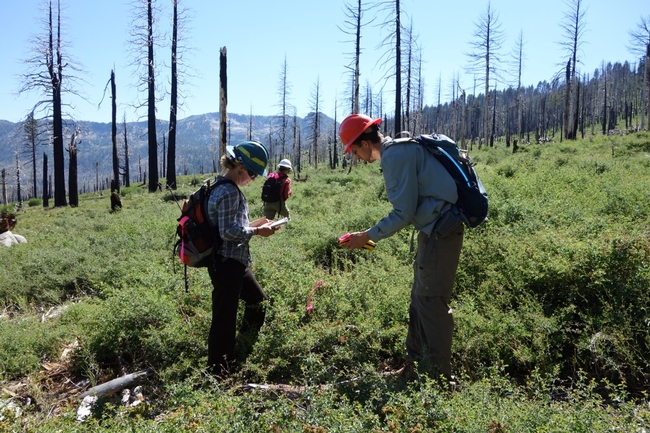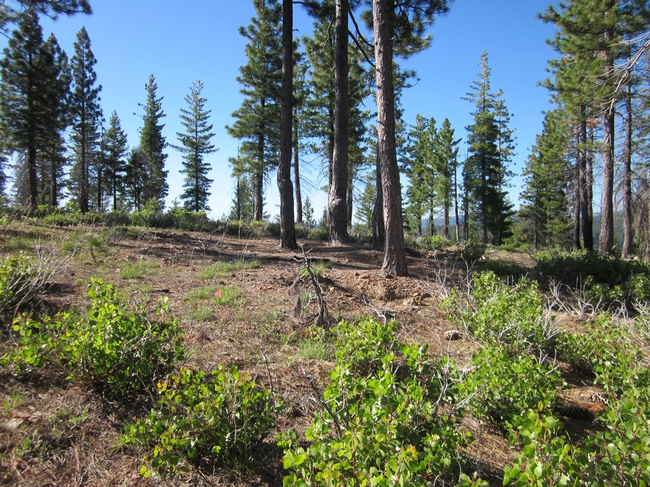Connecting wildfires to climate change and drought
Longer summers, less moisture and warmer climates are predicted for California's Sierra Nevada mountains. These changing patterns bring frequent droughts and extended wildfire seasons — as seen from the current extreme drought. The question no longer is whether wildfires will be more common or more intense — they already are — but how forest managers want these fires to burn.
Jens Stevens, a postdoctoral researcher in disturbance ecology at the University of California, Davis, has tracked how forests thinned for wildfire react to high-intensity burns. The answers he found touch on growing concerns over how the state can protect its forests.
Under the context of climate change, Stevens studies how understory plants recover from wildfires, measuring the effects fuel treatments — such as the thinning of small trees — have on the way these forests burn.
Historically Sierra forests had gaps and openings, which prevented the spread of fires. More than a century ago land management agencies began a campaign of extinguishing all wildfires. Today's forest floors are blanketed with litter — fallen branches, leaves and shrubs — and many of the fire-tolerant pines have been replaced by firs, which handle shade well but act as fuel sources.
Stevens' research showed fuel treatments encourage resilience to wildfires, giving forests a greater ability to withstand a burn. Under really hot, dry summer conditions this makes a powerful difference.
“If you get warmer temperatures you're going to dry out the fuels,” says Stevens. “If we want to retain forest-dominated landscapes, we don't have the choice of doing nothing, because eventually these stands are going to burn."
To preserve forests, Stevens looked to native plant diversity under each management strategy. After a high severity fire, the tree canopy is non-existent. This new high-light environment favors other species, such as shrubs and flowering plants, which crowd out young trees.
In treating a stand before a fire, land managers are already encouraging plant diversity and when the stand burns, diversity increases even more, Stevens discovered.
While the treatments do protect the forest and encourage plant diversity, they are expensive and lead to uncertainty over how sensitive wildlife species are affected. Yet these areas will burn eventually, Stevens argues. The choice is either a more open forest or no forest at all.
He points out research by UC Davis ecologist Malcolm North, which shows the current pace of treatments can't keep up with the extent of Sierra forests that have been fire suppressed. The US Forest Service can treat up to 40 percent of a forest before managers must start over for follow-up treatments. The other 60 percent doesn't get touched.
“So the only real way to address that is to let the fire do the work for you,” says Stevens.
The proposal North and his colleagues arrived at relies on “firesheds.” These fire-prone areas would have boundaries that allow officials to efficiently manage the fires. If a burn begins after a treatment, they don't put it out. Allowing the fire to burn fuels they would otherwise be removing frees up resources to treat other areas.
“So if it's going to burn,” says Stevens, “you need to figure out ways the fire's going to give you your desired outcome.”
Watch Stevens explain more in his seminar.
This post was adapted from a longer piece by the UC Davis Department of Plant Sciences.
Comments:
Absolutely. These results are really focused on ponderosa/jeffrey pine and dry mixed-conifer forest, and would not extend to chaparral (fire and fuel management in chaparral is another story entirely!). They also would not necessarily extend to other forest types, for example in the upper montane.




Posted by Sabrina L. Drill on July 17, 2014 at 5:38 PM